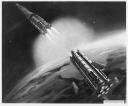Further progress on the stealthy aircraft being modelled in Rhino. The forward fuselage is packed with complex curves, and there’ve clearly been some issues in modeling them… still, it’s looking like what it’s supposed to.
As the Space Park effort showed, I’m reasonably good at modeling in CAD. However the CAD program I use has some serious limitations as far as the sort of shapes it can model as solid objects…. anything with organic contours is pretty much right out. But Rhino 3D is advertised as being the solution to that. So some while back I bought a copy and promptly ignored it. However, I’ve fired it up, and here’s the first project: an early 1970’s North American Rockwell stealthy ground attack plane. This is just a first stab at a model and is pretty wrong in some ways; much left to do. Still, at the very least it didn’t explode, so that’s something.
Finally wrapped up the Space Park tonight. Numerous hours were spent in re-building a few things… one advantage that physical modeling has over virtual is that the part doesn’t suddenly start spitting error messages at you. Nevertheless, the problems were solved and the model completed. Shown here are the parts breakdown as well as the parts layout for stereolithography. Now to get quotes…
spaceparkparts2a.jpg spaceparkparts1a.jpg spaceparkpartssprue2aa.jpg spaceparkpartssprue2ba.jpg
Irritatingly, the blog software won’t make thumbnails of all of the images… too big, I guess. So click on the titles to see ’em.
It’s in the nature of a business enterprise to try to sell as much of their product as they can. This means trying to open new markets… roles your existing products may not have originally been designed for. United Technologies tried to do that in the mid 1960’s with a series of concepts for launch vehicles using derivatives of their UA-1205 solid rocket booster for the Titan. Instead of simply being boosters, though, the solids were intended to be complete stages, and in some cases the entire vehicle. Shown here is a Saturn-class booster that uses solids for the first and second stages, with a small liquid third stage to orbit an Apollo command and service module. The perceived advantage of a system like this over a conventional Saturn was faster availability… like a Minuteman ICBM, most of the vehicle would be ready to go at a moments notice. But NASA didn’t need that, and the USAF seemed unimpressed.



































